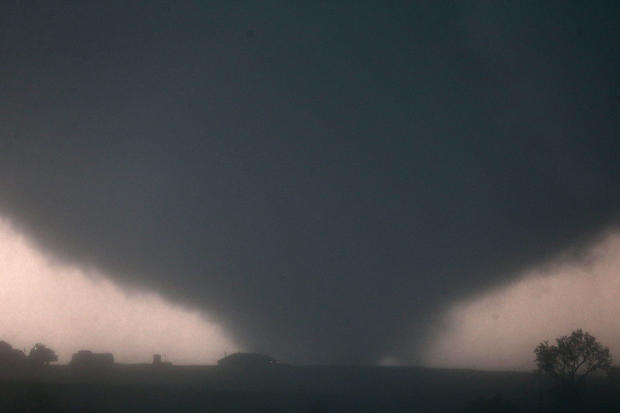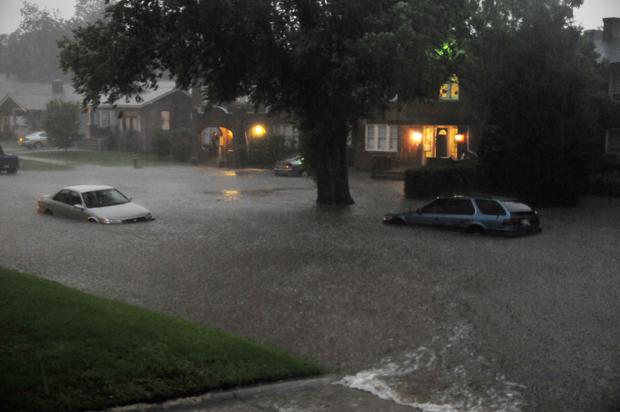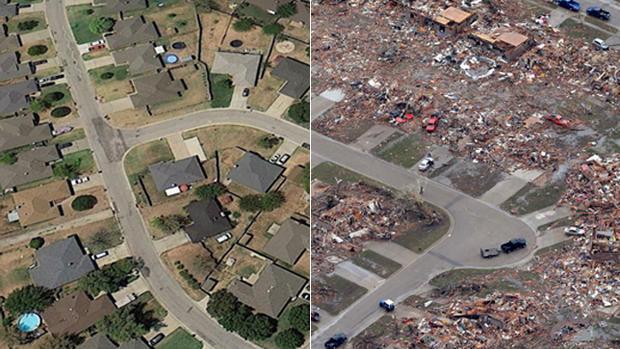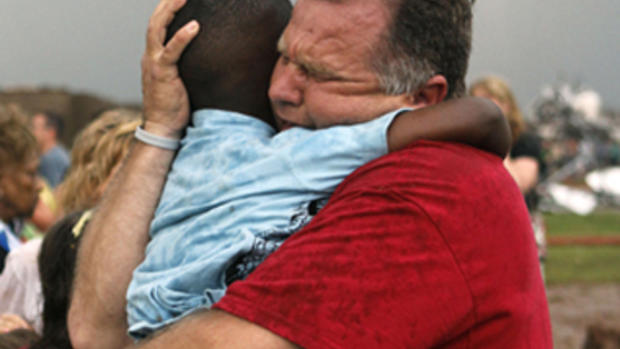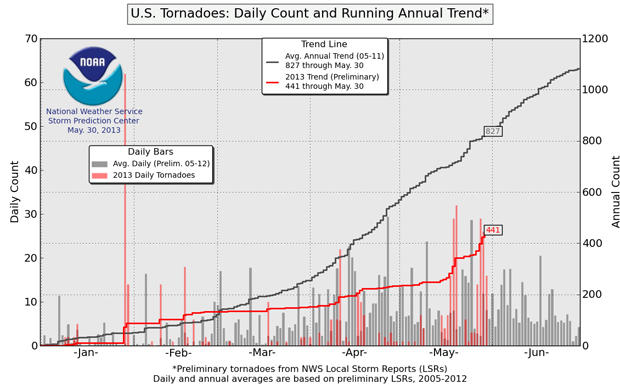Storm hits Oklahoma City area
Updated June 1, 2013, 2:26 AM ET
OKLAHOMA CITY Tornadoes rolled in from the prairie and slammed Oklahoma City and its suburbs Friday, trapping people in their vehicles as a storm swept down an interstate highway while commuters tried to beat it home.
A mother and her baby were killed, according to the Oklahoma Highway Patrol. The Associated Press, citing the Oklahoma medical examiner's office, reported that five people were killed from the tornadoes. CBS News tried contacting the medical examiner's office Friday evening, but the calls went unanswered.
Meteorologists who had warned about particularly nasty weather said the storm's fury didn't match that of a deadly twister that struck suburban Moore last week. Violent weather also moved through the St. Louis area, ripping the roof off a suburban casino.
About 50 people were hurt, five critically, hospital officials said. Newson6.com reported that
Friday's broad storm hit during the evening rush hour and stuck around, causing havoc on Interstate 40, a major artery connecting suburbs east and west of the city, and dropping so much rain on the area that streets were flooded to a depth of 4 feet.
To the south, a severe storm with winds approaching 80 mph rolled into Moore, where a top-of-the-scale EF5 tornado killed 24 on May 20.
Rick Smith, the warning coordination meteorologist for the National Weather Service at Norman, said that while the storm packed a powerful punch, it wasn't as strong as the Moore tornado.
"This storm had everything you could handle at one time: tornadoes, hail, lightning, heavy rain, people clogging the highways," Smith said.
The region was fortunate because the storm touched down mostly in rural areas and missed central Oklahoma City.
"It's not even close to anything like what we had last week," Smith said. "We were very concerned this would move into downtown. It would have been a major problem. It made all the difference that it was out in the country."
The U.S. averages more than 1,200 tornadoes a year and most are relatively small. Of the 60 EF5 tornadoes to hit since 1950, Oklahoma and Alabama have been hit the most -- seven times each.
Heavy rain and hail hampered rescue efforts in Oklahoma City. Frequent lightning roiled the skies well after the main threat had moved east. Highways and streets were clogged late into the night as motorists worked their way around flooded portions of the city.
Oklahoma Highway Patrol Trooper Betsy Randolph said troopers found the bodies of a woman and an infant near their vehicle. Randolph said it's not known if the woman was driving into the storm when it hit around 7 p.m. Friday.
Emergency officials reported that numerous injuries occurred in the area along I-40, and Randolph said there were toppled and wrecked cars littering the area. Troopers requested a number of ambulances at I-40 near Yukon, west of Oklahoma City.
"We're scrambling around," said Lara O'Leary, a spokeswoman for the local ambulance agency. "There is very low visibility with the heavy rain ... so we're having trouble getting around.
"Our big concern is to get people off the highways and get them safe," Gov. Mary Fallin told CNN.
Standing water was several feet deep, and in some places it looked more like a hurricane had passed through than a tornado. More than 86,000 utility customers were without power.
In Missouri, the combination of high water and fallen power lines closed dozen of roads, snarling traffic on highways and side streets in the St. Louis area. At the Hollywood Casino in suburban of Maryland Heights, gamblers rushed from the floor as a storm blew out windows and tore off part of the roof.
Rich Gordon, of Jefferson City, said he was on the casino floor when he heard a loud "boom."
"I didn't know if it was lightning or what, but it was loud," Gordon said.
In Oklahoma, storm chasers with cameras in their cars transmitted video showing a number of funnels dropping from the supercell thunderstorm as it passed south of El Reno and into Oklahoma City just south of downtown. Police urged motorists to leave I-40 and seek a safe place.
"I'm in a car running from the tornado," said Amy Sharp, who last week pulled her fourth-grade daughter from the Plaza Towers Elementary School as a storm approached with 210 mph winds. "I'm in Norman and it just hit Yukon where I was staying" since last week's storm.
"I'm with my children who wanted their mother out of that town," Sharp said, her voice quivering with emotion.
At Will Rogers World Airport southwest of Oklahoma City, passengers were directed into underground tunnels and flights were canceled. However, people near the area said they weren't aware of any damage.
Television cameras showed debris falling from the sky west of Oklahoma City and power transformers being knocked out by high winds across a wider area.
As the storm bore down on suburban Oklahoma City, Adrian Lillard, 28, of The Village, went to the basement of her mother's office building with a friend, her nieces, nephews and two dogs.
"My brother's house was in Moore, so it makes you take more immediate action," Lillard said while her young nieces played on a blanket on the floor of the parking garage. "We brought toys and snacks to try our best to keep them comfortable."
Well before Oklahoma's first thunderstorms fired up at late afternoon, the Storm Prediction Center in Norman was already forecasting a violent evening. From the Texas border to near Joplin, Mo., residents were told to keep an eye to the sky and an ear out for sirens.
Earlier, flash flooding and tornadoes killed three people in Arkansas as powerful storms swept through the nation's midsection, including a local sheriff who drowned while checking on residents whose house was eventually swamped by rising water, authorities said Friday. Three other people are missing.
The storms rolled across the region overnight, and more bad weather was poised to strike Friday, with tornadoes and baseball-sized hail forecast from Oklahoma, Kansas and Missouri. Flooding also is a concern in parts of Missouri, Iowa and Illinois through Sunday.
Torrential rain, including at least 6 inches in the rugged terrain of western Arkansas, posed the greatest danger the night before. In Y City, about 125 miles west of Little Rock, the Fourche La Fave River rose 24 feet in just 24 hours.
"The water just comes off that hill like someone is pouring a bucket in there," said Danny Straessle, spokesman for the Arkansas Department of Highway and Transportation. "This was an incredible amount of water."
Scott County Sheriff Cody Carpenter died while trying to check on local residents during the storm. He and wildlife officer Joel Campora had traveled by boat up Mill Creek to reach two people who called for assistance -- and the river swamped the house while they were still inside.
"Other deputies heard a loud crash," said Bill Hollenbeck, the sheriff of neighboring Sebastian County. "They thought that the bridge had actually collapsed. Looking into it further, the house had imploded as a directly result of rising waters from Mill Creek."
Carpenter's body was recovered about a mile downstream. Campora and the two women inside the home remained missing Friday, Hollenbeck said.
"We're here right now for recovery or rescue. We're still remaining optimistic about our officer at this time," said Mike Knoedl, director of the Arkansas Game and Fish Commission. "(Campora) was an epitome of what a wildlife officer should be, and he was doing what he was trained to do last night."
A man died after strong winds toppled a tree onto his car in Tull, just west of Little Rock. Authorities also are attributing the death of a woman in Scott County to the flooding, though they've released no information other than her body was found in her car.
At least nine other people were reported injured.
Up to a dozen tornadoes touched down in mostly rural parts of Arkansas on Thursday, as well as three in Oklahoma and one in Illinois. In Oklahoma, one twister bounced through the Tulsa suburb of Broken Arrow, causing some structural damage, but no injuries.
Still, Greg Carbin, warning coordination meteorologist at the National Weather Service's Storm Prediction Center in Norman, Okla., told CBSNews.com that the U.S. is experiencing fewer tornados than usual this year.
"Although we did have a couple days in January that were active, we have seen below-normal activity through today," said Carbin. "We're running about 25 percent below of normal."
Carbin said roughly 375 tornadoes have hit the nation thus far this year, but that number is partly based on preliminary reports that haven't been confirmed by the service.
By the end of May, around 580 tornadoes have normally hit the U.S., Carbin said.
"We're roughly 200 tornadoes shy of what would be considered a normal year," Carbin said.
The center said large hail and tornadoes are likely Friday in Oklahoma and parts of the Ozarks in Arkansas and Missouri. The areas at greatest risk include Oklahoma City, Tulsa and Joplin, Mo., where the second-deadliest American tornado on record killed at least 158 people in 2011.
Flooding is also a concern in parts of Missouri, Iowa and Illinois through Sunday.
The National Weather Service sent teams to survey the aftermath of Thursday's storms in Arkansas. The warning coordination meteorologist in Little Rock, John Robinson, said it could take days for the weather service to confirm whether tornadoes struck as flooded highways were hindering access to the storm-hit areas.
Thursday's tornadoes were all less dangerous than the top-of-the-scale EF5 storm that struck Moore, Okla., on May 20 and killed 24 along its 17-mile path.
This spring's tornado season got a late start, with unusually cool weather keeping funnel clouds at bay until mid-May. The season usually starts in March and then ramps up for the next couple of months.
Of the 60 EF5 tornadoes since 1950, Oklahoma and Alabama have been struck the most, seven times each. More than half of these top-of-the-scale twisters have occurred in just five states: Alabama, Iowa, Kansas, Oklahoma and Texas.
